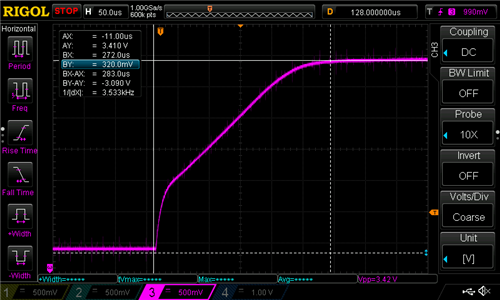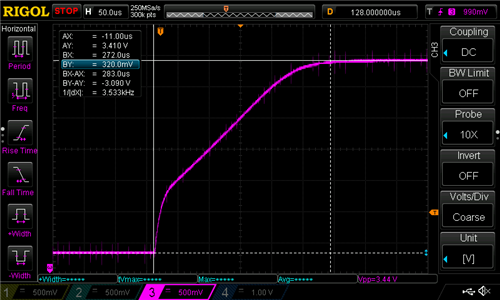I have this switch between my TPS55340 3.3V SEPIC converter and my CC3200MOD Wi-Fi module. I am trying to use it as a load switch so I can completely cut power off to the Wi-Fi module when it is not being used (95% of the time).
My issue comes when I try to run this board from alkaline batteries (4 in series to yield 6V). Due to the way alkaline batteries act the voltage drops when the current increases. When I enable the Wi-Fi switch it causes the battery voltage to droop below my 3V minimum input voltage threshold. This causes my device to reset.
My assumption is the issue is due to the Wi-Fi's two 100uF capacitors trying to charge when the switch is enabled. My initial design had R2 grounded, but after discovering this issue I went back and added in a resistor between pin 1 (R2) and ground. It did not seem to help, so I began using the scope to inspect the rise time. Regardless of the resistor value I install (1K, 10K, 100K) it doesn't seem to make any difference in the rise time of my signal.
My initial design has a 1MΩ for R1, but I have also tried the recommended 10KΩ resistor with the same results.
Below is the result with R2 pin grounded.
Below is the result with a 1K resistor.
The 10K and 100K are all essentially the same and it doesn't seem to matter if R1 is 10K or 1M.
It doesn't really matter in this application how long it take the Wi-Fi to start up (5 seconds would be OK), but I need to slow it down somehow because right now it is starting too fast and causing issues.
Why isn't my slew rate being effected and what can I do to resolve this? I would really appreciate some help on this.
P.S. An interesting side note is that if I enable the Wi-Fi switch first then then SEPIC it will start up OK (I'm assuming the SEPIC's soft start is allowing this). While this is nice to know, I need to be able to trigger the Wi-Fi on/off while keeping the SEPIC on.



